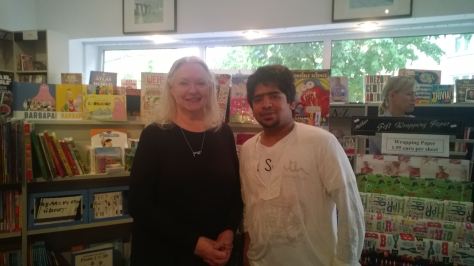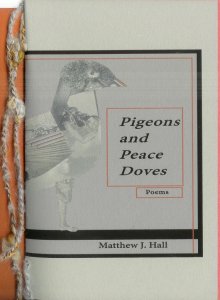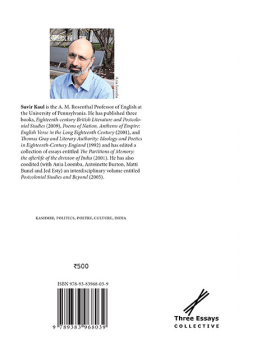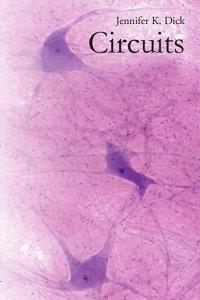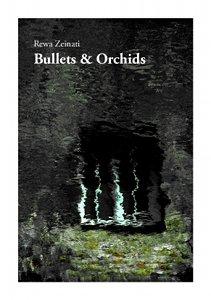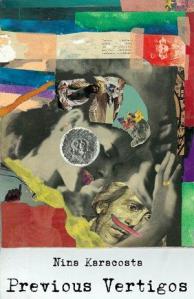November 2015 brought with it tentative autumnal showers that kept winter firmly at bay in London, and news of the latest tragedy from home. On the last day of October, as children in London were donning generic and specific costumes to prompt a sugar high, publishers were being butchered by religious fundamentalists in Dhaka. A year of similar fatal attacks on freethinking, rationalist writers claimed another life. The incident was weighing heavy on my mind when I met Ahsan Akbar, a fellow Bangladeshi writer, with a third of the penultimate month of the year over.
Ahsan is a witty poet currently at work on a debut novel that is eagerly anticipated by his reputable writer friends – and he has many of them. He is also one of the directors of the Dhaka Literary Festival. He has befriended the distinguished men and women of letters in the course of fulfilling his responsibility of bringing them to the capital of Bangladesh for the annual celebration of literature for the past half a decade. We were attending a reading by one of them. Meike Ziervogel, like me, was due to travel to Dhaka in the following fortnight. She, like me, trusted the team behind the festival to have our best interests at heart, and remained committed to attending it. After a rendition of her precise, haunting prose, she reiterated this as she signed copies for waiting fans. She echoed the defiance of another guest, the esteemed Jon Snow: Now was the time to stand with Bangladesh, to show solidarity with those who were fighting for the soul of the country.

These were the two memories – one deplorable, the other inspirational – with which I boarded the plane on the eve of the festival. I had opted for the functionality of the Abu Dhabi airport over the ostentation of the one in Dubai as my stopover. I sent a few messages to friends and family over WhatsApp and Facebook before departing for Dhaka. Upon arrival, I checked for replies repeatedly, but none came. The government had blocked most social media and messaging applications as a security measure following the murders and as a prelude to the imminent hangings of convicted war criminals. The religious right had called a hartal – political strikes that had steered so far from Gandhi’s principles of peaceful protest that success was measured in casualties and the number of vehicles burned – in response to the sentences, on the first day of the festival. This was especially problematic for me since I had to travel the length of the city to get from my parents’ residence, where I was staying, to the Bangla Academy, the historic location of the festival.
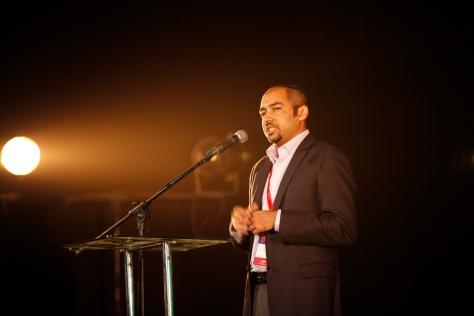
I relied on my knowledge of safe modes of transport during hartals, and arranged an ambulance. This proved to be an unnecessary precaution, taken by an expatriate whose knowledge was showing some signs of rust. The famous resilience of Bangladeshis was in full display on the streets, flouting the inconsiderate, senseless moves of supposed politicians to go to work. The violence of hartals, the full force of which was felt in 2013 when they claimed more than a thousand lives, had also abated. I was greeted by a police roadblock when I reached the festival premises. The road on which sat Bangla Academy had been closed at the behest of the organisers. I walked past patrols of bored policemen sprinkled throughout the closed road, up to the entrance and, after being given a VIP pass, made my way to the Main Stage for the inaugural. The ambulance had collected me only after ferrying the hospital staff, which meant that, according to the schedule I was handed as I entered, I was late. The minister who was declaring the festival open, however, was running on Standard Bangladeshi Time. Therefore, despite my best efforts, I was early.
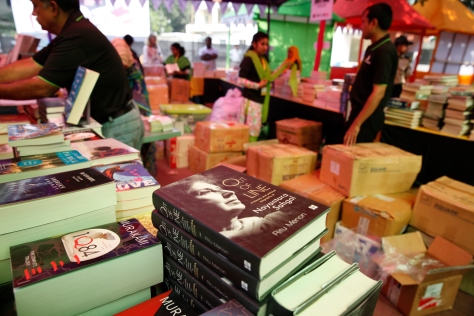
Once it started, the first three hours, encompassing a musical recitation that I had missed, the inaugural and an opening plenary, set the tone for the rest of it. K. Anis Ahmed, a well-known Bangladeshi writer and publisher, and another festival director, delivered a succinct and comprehensive address in English and Bengali, establishing firmly the multilingual nature of the event. He touched on the absentees, as did Ahsan in his address. There are two types of writers in Bangladesh. The first is diligent and dedicated, constantly developing and contributing significant pieces, often with no reward. A handful of them had paid with their lives during the year, as their predecessors had during the independence movement. Their numbers had already been dwindling, arguably even skipping a generation since the new nation emerged. The second wants the fame without the work, the superficiality over the substance, the label that has not been earned. The growing English-language scene has seen more of the latter, the frauds, crawl out of their holes and multiply, believing their English medium education and overseas university degrees have equipped them to string two sentences together and pass themselves off as writers. They succeed at conning their way to the limelight because Bangladesh has simultaneously revered writers as intellectuals – dating back to the language and independence movements, and those who were slaughtered by Pakistani agents, to silence them – and had low rates of literacy and education.
A pratfall of these charlatans did not leave their Gulshan and Baridhara palaces in support of the written word and the freedoms of thought, speech and expression. At a time when these fundamental freedoms that make us human are under threat in Bangladesh and the region, when luminaries from foreign shores did not hesitate to show solidarity with us, the reprehensible actions of those who dare call themselves writers and Bangladeshis were conspicuous, were criminal. A few of the foreign guests had similarly absented themselves, citing security concerns. They should be reminded of what it means to be a writer. “We need to celebrate literature, and it is especially important to celebrate it in these troubled times when it is under attack in so many parts of the world…[W]e all belong to the country of imagination, and when an iron curtain comes down on our imagination, then it is time to act, and to act as writers,” said Nayantara Sahgal in her effortlessly eloquent keynote speech at the inaugural. The festival had begun, its special significance and greater duty to the world and literature underlined.
The opening plenary, vague and imaginative in equal measure in its title, “The World is Round”, set its sails to the wind unleashed by the inaugural. No sooner had the first question been asked by the moderator than the discussion took on a revelatory political flavour that audience participation at the end encouraged rather than dampening. Jon Snow, Jude Kelly and Ramachandra Guha represented the fair, rational and brilliant truth-seeker, the reactionary whose single-minded worldview is expressed in every sentence uttered, and the artful centrist that lend sensible political discourse the perfect blend of information and entertainment. Appetite whet, I raced to the Lawn, another of the six locations used for concurrent sessions – there were at least three running at the same time for the rest of the festival – for a quick look at the launch of Himal Southasian’s special issue on Bangladesh, before interrupting it to take in a tete-a-tete about culture and performance art through the ages between two of Bangladesh’s most celebrated actors, Aly Zaker and the effervescent Asaduzzaman Noor. The former, especially significant as one of two international magazines that had dedicated entire issues to Bangladesh for the very first time, kept the political flame that had been lit alive, while the latter delivered on its promise of mirth. The organisers had performed a minor miracle by getting the schedule back on track by then. I took a break to avail myself of the Authors’ Lounge’s hearty lunch service.
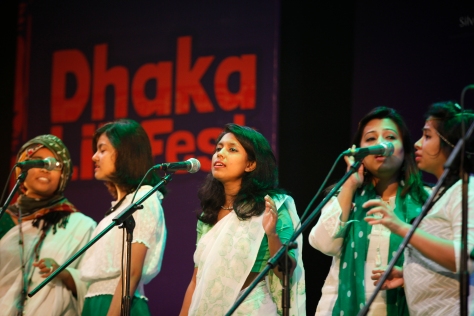
A steady trickle of people was beginning to grow the sparse audience of the morning – a result of a working day and the trepidation of a hartal – by the time I made my way back to the sessions on offer. The first day saw the festival stretch its poetry muscles, showcase Bangladeshi writing, and delve into science, courtesy of Harold Varmus, an American Nobel Laureate who had defied his State Department’s overly cautious travel advisory. I met Naushad Ali Hussein in between sessions, a primary school classmate I had last seen almost two decades previous. Naushad, it seemed, had veered away from his mathematical inclinations at school towards the arts. He, along with the ever-exuberant Rajib Rahman Johney and Karina Zannat, was leading an energetic, enthusiastic and incredibly helpful team for Jatrik, the production company behind the festival. Headquartered inside what appeared to be a box office encased by glass converted into an office, the three were called on to solve problems of varying magnitudes – a jetlagged guest needed to go to the hotel, another needed a mobile phone charged, yet another needed to know where best to get jamdanai saris and how to get there, while another was nowhere to be found – during my poor attempt at catching up with Naushad. I was approached by a smiling volunteer, identifiable by the distinct purple “DLF 2015” t-shirt she had on and a similar badge to mine which gave her a different designation, who asked if someone had been assigned to me. When I answered in the negative, she promptly rectified the oversight. Progga Noshin is a bright, cheerful student from the University of Liberal Arts Bangladesh, one of the private universities that have grown in the country since the turn of the century, to try to make up for the egregious shortcomings of the state institutions. She made the remainder of the festival both enjoyable and considerably easier to navigate.
Dhaka may be unfashionable compared to some of the exotic hosts of literary festivals, but the emphasis on programming in 2015 made it a standout event. The main motivation behind the attending public was the quality of the programming and the topics of discussion, to learn from and be inspired by substance, not superficiality. An example was the session on science fiction on the second day. None of the panellists were household names in Bangladesh, but the interest in that particular kind of writing had resulted in all the seats being taken, people cramming inside and standing where they could, and two small queues outside the KK Tea Stage’s ajar doors. They caught the Cuban rock-star and writer, Yoss, explain how his mother cries when she reads his stories, and when she asks him how he can keep a dry eye, he replies, “My tears are on the page.” The hunger for science fiction had been met with a constructive dialogue between him, Marcel Theroux, Ranbir Singh Sidhu and the Bangladeshi writer Saad Z. Hossain, and the audience that plumbed the depths of the genre’s standing as more than pulp-fiction, as being relevant to understanding life through the ages, the human condition, even politics.
The second morning had already brought a pleasant surprise. Scholastica, one of leading Bangladeshi English-medium schools, had arranged a school trip to the festival on the Thursday. The hartal had forced them to cancel. The students were not to be deterred, however. They had forsaken their weekend sleep and convinced their teachers to reschedule the trip for Friday. Some had had to wake up at five in the morning to join the group that arrived at Bangla Academy before its doors had opened. Their hunger and determination gave the lie to the age of media sensationalism that constantly reminds us of the erosion of values and digitalisation killing literary and intellectual pursuits. Identifiable by their uniforms – white shirts and navy blue trousers for the boys, white shalwar-kameez with navy blue dopattas for the girls, the white in each case carrying the multi-coloured school logo – I spotted them listening intently to Sandip Roy, Mahesh Rao and myself discuss short stories with the Nepalese journalist Bikash Sangruala. Mahesh’s likening of short stories to flings and novels to long-term relationships was exemplified the former pair’s irrepressible wit and verve that entertained a largely young audience shaking off sleep. I later learnt that students of some of the other established schools had joined those from Scholastica, their civilian clothing allowing them to blend into the crowds thronging sessions on Palestine, Cuba, translation, feminism and the minor languages of Bangladesh.
Jon Snow, Kunal Basu and Zafar Sobhan were especially generous with their time when approached by the young minds in between sessions. The latter is the editor of Dhaka Tribune, a formidable English-language daily that was the festival’s title sponsor. En route to a session, I stopped by their stall to see what they were doing. Rumana Habib oversaw a warm, spirited and accessible team. Their planned activities included a poetry booth – a highbrow version of the carnival kissing-booth – and several workshops. This hands-on involvement with the festival was a refreshing change from the elitist approach adopted by Dhaka Tribune’s predecessor, The Daily Star. In an effort to live up to the high journalistic standards set by its British tabloid namesake, its coverage of this significant event in a country where freedoms and the space to exercise them were ever-shrinking was reminiscent of the government’s approach to said freedoms: denial, rejection and refusal. I was amused to see the supposedly most widely circulated English-language newspaper displaying the pettiness of a Hindi soap opera villain while its successor showed why it had been left at the altar for the other.
There had been an air of elitism and nepotism about the festival in its previous, imperialist form, which was absent in the reborn version. While the director past walked with a permanent spotlight hanging above, the directors present opted for bringing Bangladesh to the world over self-promotion. The Wasafiri special issue on Bangladesh, brought into focus in the warm early-winter afternoon of the second day, epitomised this. The only independent nation to emerge from Bengal, the crown jewel of British India and the region most coveted by the kings that preceded it, has failed to live up to the heady heights of its cultural heritage. Those within the country, spurred on by false senses of patriotism or nationalism and delusional pride, cling to that heritage with the zeal of a convert. They have not provided those without with a reason to have faith. Bangladesh remains absent in global conversations because the wealth of its Bengali literature has not been translated and its sparse English literature has not been communicated to the world. The Wasafiri issue is a step towards rectifying decades of negligence on part of the self-appointed gatekeepers and doyens of Bangladeshi culture. In that regard, it was a personification of the festival.
I carried this optimism into the final day. Conscious of its impending end, the festival paraded its greatest hits. Jon Snow charting his life and its intersection with key moments of contemporary history was a delectable breakfast, Nayantara Sahgal’s liberalism and activism a luscious lunch that came with a dessert course comprised of lively discussions about London and Kolkata. Tea came in the shape of cricket, the passionate nation’s favourite sport, and science with Harold Varmus. I satiated my palate, having already enjoyed my personal highlight the day before. I had spent an hour and some change in the company of Jon Snow. What was supposed to have been an interview became one of the most inspirational, enlightening and awe-inspiring experiences of my life. The wisdom he had imparted with deft articulation was admirable, but being in his presence had reminded me of what it really meant to be human, and that was invaluable. As twilight approached on the last day, a travelling troupe of performers whose bus had broken down, delaying their arrival at the festival by a quarter of a day, gave a mesmeric folk-drama rendition in the Lawn that was painfully beautiful. They had not eaten since breakfasting at dawn, and the rural-dwellers were in the cultural heartland of the classist urban capital, but their discomfort was absent as they entered a trance and exploded onto the stage.
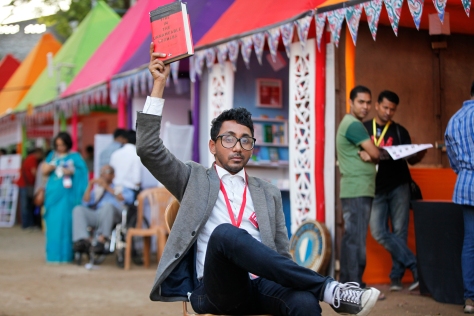
I slipped away to the Main Stage, to hear the closing remarks of Professor Emeritus Anisuzzaman. His name, like those of many others celebrated at the festival, was on the various hit lists released by the fundamentalists, and he had received death threats in the days leading up to it. His speech was one of defiance and endurance, one of the need for Bangladesh to converse with the world through its literature, one of what it can mean to be a Bangladeshi. I stepped out into the Dhaka dusk, the spell cast by his powerful words reverberating within me defining the festival. I saw a rush to the exit as rumours about the hangings of the war criminals and the response of the fundamentalists in their aftermath abound. Dhaka Literary Festival had ended, but it was not over. A microcosm of the nation that was birthed by indubitable hope and, despite being pushed towards becoming a failed state, remained full of promise and indomitably hopeful, it was necessary. A country that would not have been born had it not been for words now sees people killed because of them. Although the millions who were Charlie Hebdo value brown lives less, there is a home-grown platform of thoughts and ideas that demands the world take notice of Bangladesh, and demands Bangladesh fight for its soul.
BY IKHTISAD AHMED

